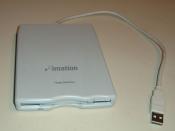There are many similarities and differences between computer storage and computer memory. First, let me define both terms. Computer storage is a place that a computer permanently stores data, such as program files and related data when not in use. Computer memory, however, is defined as a place where the computer stores data as it is entered, and where it loads program data in order to run it. Just by definition, the primary difference becomes obvious: storage is permanent while memory is only temporary. On the same note is volatility. RAM (the most commonly referred to type of memory) is considered volatile, and needs a constant supply of power in order to maintain the data it holds. Storage devices, such as tape drives, optical drives, removable hard drives, and magnetic disk drives are all referred to as 'non-volatile', meaning that they retain any information that they store, even without a power supply.
Storage is typically much larger in capacity than memory. The last, and sometimes most important, difference between the two is speed. RAM (random access memory) is much, much faster in terms of access speeds than storage is, but is also quite a bit more costly.
Next, I'll move on to the similarities. Both types of media are typically used to access any individual program. The program itself is usually kept in storage, and instructions on how the operating system should interact with that program are loaded into physical memory for fast operation. Both storage types use the same unit sizes for measuring data, such as byte, kilobyte(KB), megabyte(MB), gigabyte(GB), and Terabyte(TB). In addition to RAM, there is also ROM (read-only memory), whose sole purpose is to permanently store instructions that the computer needs to operate.
The more our technology advances, the less we will see differences between...


